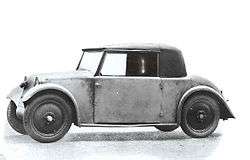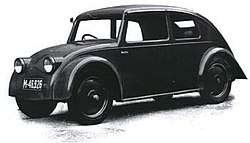Tatra V570
The Tatra V570 was a prototype early 1930s car developed by a team led by Hans Ledwinka and Paul Jaray. The aim of the construction team was to develop a cheap people's car with an aerodynamic body. However the company's management decided that the revolutionary ideas introduced in the prototype should be introduced in large luxurious cars, and therefore the team abandoned the project of small cars in favour of the Tatra T77, the world's first serially produced aerodynamic car.[3] The project of a small car was later continued and led to introduction of the Tatra T97. The second V570 was built in 1933, two years before the first Volkswagen, which bears a strong resemblance to the Tatra – it was misappropriated in the opinion of Tatra, by Adolf Hitler and Dr. Ferdinand Porsche in circumstances about which the German company remains intensely sensitive.[4]
| V570 | |
|---|---|
| Overview | |
| Manufacturer | TATRA, a. s. |
| Production | 1931 initial prototype 1933 second prototype |
| Assembly | Kopřivnice, Moravia, Czechoslovakia |
| Designer | Erich Ledwinka, Erich Übelacker, Hans Ledwinka, Paul Jaray |
| Body and chassis | |
| Class | Subcompact Economy car |
| Layout | RR layout |
| Powertrain | |
| Engine | 854 cc air-cooled boxer |
| Transmission | 4-speed manual[1] |
| Dimensions | |
| Wheelbase | 2,320 mm (91.3 in)[2] |
| Length | 3,800 mm (149.6 in)[2] |
| Width | 1,400 mm (55.1 in)[2] |
| Height | 1,440 mm (56.7 in)[2] |
| Chronology | |
| Successor | Tatra T97 |
However Tatra V570 itself doesn't appear the first design as it has resemblance to automotive sketches by Hungarian engineer Bela Barenyi, whose works date as early as the late 1920s and published in 1934.[5]
History
In the early 1930s Tatra engineers, under the direction of Hans Ledwinka's son Erich and design engineer Erich Übelacker, started work on the development of a small people's car with a rear-mounted engine in a backbone frame. Ledwinka believed that a rear-mounted engine RR layout would bring with it several big advantages – i.e. reducing the efficiency loss, noise and vibration of the driveshaft of the FR layout. No driveshaft meant there would be a flat floor with no need for central floor tunnel so that the passengers' seating position would be lower and well forward of the rear axle, which would lead to a lower centre of gravity, more favourable inter-axle weight distribution, and lower overall height. Mounting the engine in the rear would mean shortening the front part of the body to make a longer tail possible, which was consistent with the laws of aerodynamics. Also, engine noise would not disturb the passengers and would not be heard when driving at a speed of over 50 km/h. Air-cooling would be simpler and more effective at coping with the extremes of temperatures during the depths of winter and height of summer, than water cooling systems of the time, considering the climate in Central Europe.[6] As the company was considering starting to manufacturing aeroplanes, it got experience with laws of aerodynamics and decided to apply them for the prospective car.[1]



First prototype
The initial proposal of the concept was presented by Tatra designer Erich Übelacker, who previously worked on the Tatra 57 car. However, at the time Übelacker's proposal was strongly criticised by Ledwinka. When he was facing the prospect of leaving the company, he finally presented the project with aerodynamic car body with a teardrop rear, which would be used to accommodate the whole drive-line of the car. Paul Jaray, the noted Zeppelin designer, produced a prototype aerodynamic body for the Tatra 57. Übelacker was a mercurial young engineer with great imagination and a lot of enthusiasm - however he lacked the perseverance needed to bring his ideas to fruition, and that is when Ledwinka stepped in to finish the work which might otherwise have come to nothing. The new design was initially tried under a body which was not aerodynamic (the first V570 prototype).[1] Two pieces of the first V570 were made in 1931.[7]
Second prototype
The work on the second prototype's aerodynamic body started. The second prototype was based on patents using streamlining principles of Paul Jaray. It was very similar to the first prototype, but this time it was equipped with an aerodynamic body.[6] The lower part was following the lines of an aeroplane wing, while the upper part was supposed to be like a second wing added on top. The rear mudguards were incorporated into the body and the rear wheels were covered. The remnants of front mudguards became part of the front bonnet. The running boards were abandoned and accessories (i.e. door handles) were recessed into the body. The floor was flat and enclosed. The front window was inclined at a 45° angle.[1]
The positioning of the engine at the rear and its cooling became a difficult task, which is demonstrated by the large number of patents considering the airflow to the rear engine compartment which Tatra registered at the time.[8] The initial prototype had an engine derived from the Tatra 57 two-seater.
The final design had four seats. The engine was a two-cylinder air-cooled boxer 854 cc with a power rating of 18 HP at 3500 RPM. The engine, gear-box and half-axles were of unitary construction. The simple two door body had a timber frame. Although it was made purely to test different design ideas, it had good handling and could easily reach speeds of 80 km/h.
The responsibility for final construction was given to Hans Ledwinka's son Erich.
Serial production was considered, however the Tatra 57's outstanding commercial success precluded it, the principles of V570 were later used in the Tatra T77 and Tatra T97 designs.
The car was later sold and its owner used it daily for 30 years, before it was handed back to Tatra factory museum.[1]
Streamlined Tatras
- Tatra V570 1931, 1933
- Tatra 77 1933-1938
- Tatra 87 1936-1950
- Tatra 97 1936-1939
- Tatra T600 Tatraplan 1946-1952
- Tatra T603 1956-1975
References
- "Aerotatra - Tatra V570". aerotatra.czweb.org. Retrieved 2010-06-11.
- "Technický popis T V570". aerotatra.czweb.org. Retrieved 2010-06-11.
- "Cars & history: Tatra T77 & T77A (1933–1938)". Tatra. NL: Demon. Archived from the original on 2006-10-12. Retrieved 2010-06-11.
- Mantle, Jonathan (1995), Car wars: fifty years of greed, treachery, and skulduggery in the global marketplace, New York: Arcade.
- McHUGH, DAVID (2019-07-09). "From Nazis to hippies: End of the road for Volkswagen Beetle". AP NEWS. Retrieved 2019-07-09.
- "CARS & HISTORY: Start of the aerodynamic era (1931-1933)". tatra.demon.nl. Archived from the original on 2010-05-17. Retrieved 2010-06-11.
- Tatra - Passenger Cars, Karel Rosenkranz, TATRA, a. s., 2007
- "Tatra oldtimer:T77 (czech)". Retrieved 2010-05-17.
External links
| Wikimedia Commons has media related to Tatra V570. |